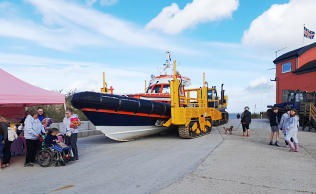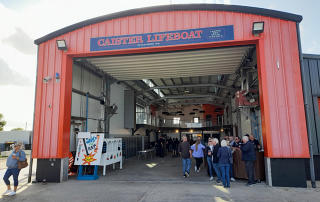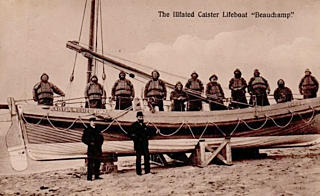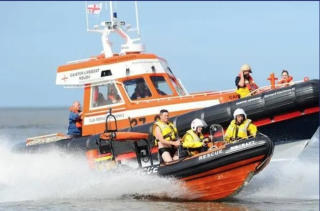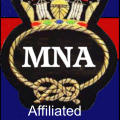
INDEPENDENT LIFEBOATS

Incident Reports
Hemsby Broads Rescue was paged by Humber Coastguard last night at 23:40. Our
assistance was requested by local Coastguard teams to help with the evacuation of a
female in her seventies who had fallen on her vessel earlier in the evening.
It was agreed by the Coastguard and the medical team on scene that the best option would
be to navigate the vessel to a suitable mooring close to the Ambulance, as the alternative
would have been a significant walk and not in the best interests of the casualty or
emergency crews.
We launched Broads Marley and, after locating the casualty vessel, put two crew on board
to navigate to the selected mooring close to the ambulance. Helmed by a lifeboat crew, the
vessel proceeded under escort from the Broads Rescue Boat and was safely repositioned.
We thank the Coastguard teams from Bacton and Winterton and the Ambulance Crew.
Once the casualty was safe on board the ambulance Hemsby Stood down and returned to
base for post-emergency administration and clean down at 01:45.
!st November 2023 - Hemsby Lifeboat
!2th November 2023 - Sandown & Shanklin Lifeboat
!3th November 2023 - Sidmouth Lifeboat
Two peoplerescued after their boat caught fire at sea.
Lifeboats and a coastguard rescue helicopter responded to a mayday call received from
the boat off Ventnor, Isle of Wight, at about 10:20 GMT.
The Maritime and Coastguard Agency (MCA) said: "Those on board the vessel were all
accounted for and safe."
The boat drifted for several miles, with a plume of smoke visible from southeast coast of
the island, before eventually sinking.
Sandown and Shanklin Independent Lifeboat said its crew stayed with the craft as it
drifted to monitor the fire and debris.
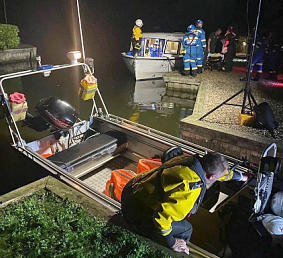
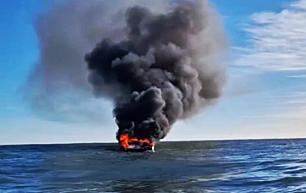
Sidmouth Independent Lifeboat was tasked alongside Coastguard Helo Rescue 187, Beer Coastguard and Exmouth Coastguard
search teams to reports of a missing high-risk male believed to be in the vicinity of Mutters Moor.
The Lifeboat was tasked to do a shoreline search between Sidmouth and Sandy Cove.
With nothing found, the lifeboat was stood down at 04:05
Merchant Navy Association Boat Club
(Affiliated to the Merchant Navy Association National Charity)
Caister Independent Lifeboat Station
The first record of the Caister Beach Company in 1791 shows that they used
boats named 'Assistance' and 'Prince Blucher'. The main purpose of the Beach
Company was salvage, and the coast around Caister with the array of
treacherous sand banks provided a good living for the crews of the gigs and
yawls which were the principle rescue vessels of the day. Poor navigation,
badly maintained ships and indifferent crews all combined to produce tragic
results in bad weather, one example being in November 1807 when a total of
144 bodies were washed ashore following a gale. In 1836 it was reported that
23 vessels had been stranded on the Yarmouth beach following a November
storm.
It was not without risk to life and
limb as the disasters of 1847 and
1885 and the Newport disaster of 1845 illustrated, 12 men from Caister lost their
lives. As well as salvage the Beach Company along with the Rocket Brigade also
carried out lifesaving when a lifeboat was first stationed at Caister in 1845 it was
the Beach Company that provided the crew. Ben Hodds became the first
Coxswain and the work of life saving began firstly, under the auspices of the
Norfolk & Suffolk Shipwreck Mariners Association.
In 1846 the Norfolk & Suffolk Shipwreck Mariners Association replaced the
second-hand boat with a new lifeboat, built at the Yarmouth yard of Branford, a
boat of the Norfolk and Suffolk design, All along the East Anglian coastline similar
arrangements were being made by to provide lifeboats. A lookout was erected on the beach from where the beach-men kept a
constant watch in bad weather. The Beach-companies worked to a strict set of rules and regulations' governing the payments
and distribution of any salvage money the company received and membership of the company was strictly limited, in the case
of Caister to 40 men.
In 1857 the RNLI took over responsibility for all lifeboats and in 1865 a new boat, a gift from the Birmingham Lifeboat Fund,
arrived at Caister. This 42 foot boat, powered by 14 oars and sail, was named the JAMES PEARCE BIRMINGHAM No
2.During its 18 years’ service at Caister this boat was used to save 484 lives. Such was the great need for lifeboats at this
period that a second station was opened at Caister in 1867 with a boat named THE BOYS, purchased with donations received
from the Routledge's Magazine for Boys. This boat was built at the Yarmouth yard of Beechings, famous for their lifeboat
design and construction.
In 1875 this boat was renamed GODSEND and three years later the other Caister boat, the JAMES PEARCE, was renamed
COVENT GARDEN. In the days of the pulling and sailing lifeboats the crews could be at sea for many hours, in severe weather
from which they had virtually no protection. The only aids towards finding the vessel in trouble were flares, rockets, and the
many light ships that marked the sandbanks and navigation channels. Even the task of launching a lifeboat could take many
hours, the heavy boat having to be manhandled down the beach and through the breakers.
In 1892 a boat named the BEAUCHUMP replaced the GODSEND. This boat had
been in service for nine years when on a dark November night in 1901, disaster
struck the Caister beach-men. The Lifeboat had been launched but about an hour
later was found capsized on the beach and only three of the crew of twelve were
saved. In the wake of this disaster the a veteran lifeboat man, James Haylett,
was awarded the RNLI gold medal for his actions in rescuing the three crew and
at the inquest into the accident he made a statement that has resulted in the now
famous phrase "Caister Men Never Turn Back" - click to listen to the song.
A replacement boat arrived in 1903, called NANCY LUCY. In 1929 the No1
station was closed. The Nancy Lucy was re-placed in the same year with the
CHARLES BURTON, which was in service at Caister until 1941. The Charles
Burton was the last sailing lifeboat in East Anglia. The first motor powered lifeboat at Caister was the JOSE NEVILLE and the
introduction of this boat heralded a new era for the station. For the first time tractor power was used to launch the boat from a
special trailer and fewer crewmembers and shore parties were required. This new era also brought the disbandment of the old
Beachcompany after almost 150 years.
In 1964 the ROYAL THAMES, a boat of the Oakley design, replaced the Jose Neville. The 1960's saw a reorganisation of RNLI
stations around the country and in 1969 it was decided to close the Caister station. At this time the station held the proud
record of having saved more lives than any other RNLI station in the British Isles, a total of 1814 persons.
In 1969 after 124 years of a lifeboat station at Caister the RNLI decided to close the station, there was public outcry as Caister
held the record for the most lives saved by any lifeboat station in the British Isles. The crew, led by the veteran mechanic Jack
Skipper Woodhouse decided to have an independent station which immediately took over on the day the RNLI withdrew. At
first a small fibre glass boat was placed on station then an inflatable. The Caister Volunteer Rescue Service was formed to
maintain the long tradition of lifesaving at Caister and fund raising began to acquire another full size lifeboat.
In 1973 the CVRS purchased an ex-RNLI boat of Liverpool design and renamed
her SHIRLEY JEAN ADYE, formally launched on August 5th 1973, this vessel
carried out several memorable rescues and the crew were awarded vellum
certificates in 1986 for the rescue of the crew from an oil rig supply ship aground
on the Scroby Sand in a force 8 gale.
In 1986 the crew and committee decided the time had arrived when the
SHIRLEY JEAN ADYE would have to be replaced because at 8 knots top speed
she was slow and speed is of the essence. In April 1987 a £400,000 appeal was
launched to replace this boat with a modern, faster lifeboat and a 12 ton, 38 foot,
Lochin Marine Extended Brede Class boat was fitted out at the Yarmouth yard of
Goodchild Marine. Powered by twin Ford Sabre Diesel of 240hp, the new boat
was officially launched on June 18th 1991 by HRH Princess Alexandra and now
maintains the traditions of the Caister station which go back 200 years, to the first Beach Company of 1791. Caister is the only
independent station in the country to operate with a full size lifeboat. The new lifeboat was named The BERNARD
MATTHEWS, after the Norfolk turkey farmer, who is a great supporter of the station.
The BERNARD MATTHEWS has been the busiest lifeboat ever on the station,
carrying out many remarkable rescues. The sad epic on the 8th - 9th December
1993 truly demonstrated why Caister has the motto "Caister Men Never Turn
Back", but whilst no one was saved the letter from the commander of HMS
Nottingham is clear. On the 1st October 1995 the yacht "Sequina" was aground
on the Scroby Sands in a force 7 gale. Dick Thurlow and the crew plucked 4
people from the capsized vessel. This was after the previous Sunday the crew
had rescued 9 people aboard the Dutch yacht "Madame".
Recently the CVRS changed its title to CVLS - Caister Volunteer Lifeboat Service
a more appropriate name for the organisation. Once again time has caught up
with the lifeboat, The BERNARD MATTHEWS, though still a superb sea boat
ideal for the conditions offshore Caister, now design & technology has advanced
apace since the mid-80s when the boat was designed. Today water jets have replaced propellers. Therefore the officers of the
Caister Lifeboat have been for the last 18 months evaluating a replacement for the present vessel, and have concluded
following exhaustive tests that the Dutch KNRM have the lifeboat for the job, perfectly suiting the needs of the station in future.
